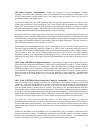29
center of its filter’s band pass like in the other modes if the [CARRIER] button under the frequency display
has its light on. Its performance should be similar to the low distortion but it selects the instrument’s
widest filter.
Its important to realize when using this mode that the instrument’s tracking oscillator’s output signal is
always at the RF frequency of the center of the instrument’s filter band pass and offset from the display
frequency. I haven’t found a use for the tone frequency display feature, activated by the [TONE] button
for RF work. It’s designed for tuning on a tone in the band pass of a SSB channel on telephone lines.
Both [CARRIER] and [TONE] buttons do not affect tuning when the instrument is out of the SSB channel
measuring modes, even when their button lights are on. When the instrument is in the either of the
selective modes and the CENTER frequency annunciator is on the display frequency is always the filter’s
center RF frequency. For level measurements of very weak SSB signals, try the low noise selective mode
and look for signs of intermodulation, i.e. increased signal strength readings before recording any level
measurements.
With the A and B versions this mode automatically selects the wide band pass filter. Signal level
measurement errors can be introduced because of a WTD audio filter is also switched in which reduces
audio levels below 400Hz and above 2000Hz. You may want to use the widest filter without the WDT
noise filter if you have the 003 filter option in your instrument.
16.6 Wideband - Use only for broadband non-selective measurements like in our audio amplifier
example. The frequency tuning and tracking oscillator features are disabled in this mode since they are not
needed. It could be used for selective measurements of single signals in devices or electronic circuits, but
its use will result in a much higher instrument noise floor of around –70dbm compared to –117dbm to –
120dbm in the other modes.
16.7 Impulse Noise – Can be used for measuring the number of pre set level peaks over a preset time
interval. This mode is not available on the C version. This mode is useful for measuring shot or impulse
noise from amplifiers as shown in a Chapter 12. It also could be used for capturing peak power on widely
varying signals like from SSB voice signals but for accurate measurements this may be difficult and very
inaccurate when a SSB radio signal is subjected to fading.
16.8 Enhanced Frequency Accuracy – For one year after its calibration the HP3586 has excellent
frequency accuracy. To further improve frequency accuracy HP sold the 004 option, which added an
internal board with a 10MHz crystal in a temperature controlled oven for much higher accuracy and easier
frequency calibration. Some surplus instruments have this option installed or the 004 board A16 module
may be occasionally found on the used market. My instrument had this option installed but if yours
doesn’t, I think a 10MHz standard could easily be built. Obtain an accurate 10MHz crystal from
one of the common sources, California Crystal Labs or International Crystal, and build a solid state
oscillator circuit in a small RF sealed box capable of outputting at least–10dbm, 1/10 miliwatt, at 10MHz.
Mount it to the back of your HP3586 and connect its output to the EXT REF connector on the back on the
HP3586. Provide a small padder cap in parallel with the crystal and a cap in series with the crystal so it
will tune about +/- 200Hz around 10MHz for calibration. Then just calibrate the oscillator and
instrument’s frequency by simply tuning to the RF signal of one of the WWV stations at 5, 10 or 15MHZ.
Adjust the LED display frequency to the frequency of one of these stations and then place the instrument
into the frequency counter mode. To calibrate it adjust the trimmer in parallel with the oscillator’s crystal
for a display reading of all zero’s in the frequency display’s least significant digits. Even though the
crystal isn’t in an oven, your instrument should stay calibrated within 10Hz when operating at room
temperature between 50F and 80F for years just like the BFO crystals in a SSB receiver.


















